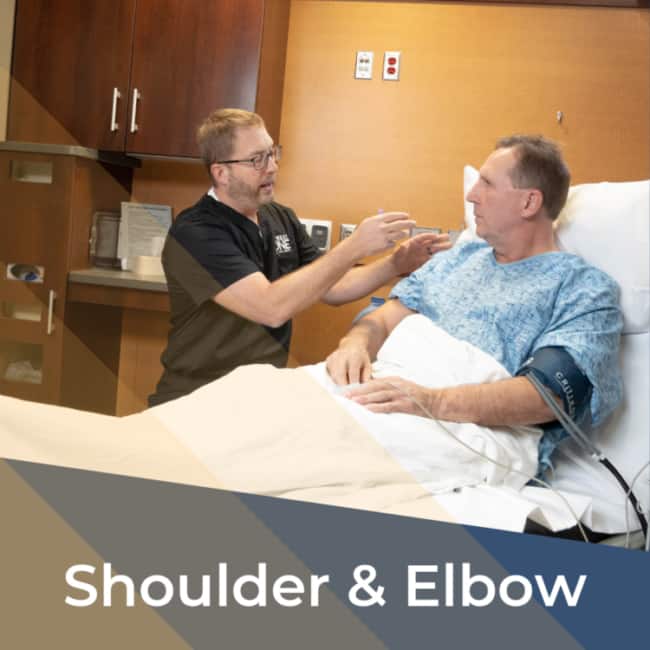Are you suffering from symptoms of a rotator cuff tear?
The Orthopedic Specialists at MD West ONE are able to properly diagnose and treat rotator cuff tears through both surgical and non-surgical treatments. If you have the following symptoms, you may want to make an appointment with one of our Board Certified Specialists.
• Pain at rest and at night, particularly if lying on the affected shoulder
• Pain when lifting and lowering your arm or with specific movements
• Weakness when lifting or rotating your arm
• Crepitus or crackling sensation when moving your shoulder in certain positions
Meet our rotator cuff tear specialists...
Rotator Cuff Tear
When one or more of the rotator cuff tendons are torn or the tendon no longer fully attaches to the head of the humerus bone, this is known as a rotator cuff tear. Most rotator cuff tears happen in the supraspinatus tendon, but they can also happen in other parts of the rotator cuff. Sometimes, torn tendons may begin fraying. When the damage continues to progress, the tendon can completely tear. This is more common when lifting heavy objects.
Warning signs of a rotator cuff tear present as limited range of motion, pain when lifting arm, and difficulty sleeping on affected side.
Your arm is kept in your shoulder socket by your rotator cuff. The rotator cuff is a group of four muscles that come together as tendons to form a covering around the head of the humerus. The rotator cuff attaches the humerus to the shoulder blade and helps to lift
There is a lubricating sac called a bursa between the rotator cuff and the bone on top of your shoulder (acromion). The bursa allows the rotator cuff tendons to glide freely when you move your arm. When the rotator cuff tendons are injured or damaged, this bursa can also become inflamed and painful.
There are two different types of tears:
- Partial tear. This type of tear is also called an incomplete tear. It damages the tendon, but does not completely sever it.
- Full-thickness tear. This type of tear is also called a complete tear. It separates all of the tendon from the bone. With a full-thickness tear, there is basically a hole in the tendon.
What is the cause of a Rotator Cuff Tear?
Several factors contribute to degenerative or chronic rotator cuff tears.
- Repetitive stress. Repeating the same shoulder motions again and again can stress your rotator cuff muscles and tendons. Baseball, tennis, rowing, and weightlifting are examples of sports activities that can put you at risk for overuse tears. Many jobs and routine chores can cause overuse tears, as well.
- Lack of blood supply. As we get older, the blood supply in our rotator cuff tendons lessens. Without a good blood supply, the body's natural ability to repair tendon damage is impaired. This can ultimately lead to a tendon tear.
- Bone spurs. As we age, bone spurs (bone overgrowth) often develop on the underside of the acromion bone. When we lift our arms, the spurs rub on the rotator cuff tendon. This condition is called shoulder impingement, and over time will weaken the tendon and make it more likely to tear.
How is a Rotator Cuff Tear Diagnosed?
Doctors diagnose a rotator cuff tear with a medical history, physical exam, X-rays of the affected shoulder, and a magnetic resonance imaging (MRI) scan.
How is a Rotator Cuff Tear treated?
There are both surgical and nonsurgical options for a rotator cuff tear, and the best option is different for every person. In planning your treatment, your doctor will consider your age, activity level, general health, and the type of tear you have.
There is no evidence of better results from surgery performed near the time of injury versus later on. For this reason, many doctors first recommend management of rotator cuff tears with physical therapy and other nonsurgical treatments.
In about 80% of patients, nonsurgical treatment relieves pain and improves function in the shoulder. Some nonsurgical treatment options may include:
- Rest. Your doctor may suggest rest and limiting overhead activities. He or she may also prescribe a sling to help protect your shoulder and keep it still.
- Activity modification. Avoid activities that cause shoulder pain.
- Nonsteroidal anti-inflammatory medication. Drugs like ibuprofen and naproxen reduce pain and swelling.
- Strengthening exercises and physical therapy. Specific exercises will restore movement and strengthen your shoulder. Your exercise program will include stretches to improve flexibility and range of motion. Strengthening the muscles that support your shoulder can relieve pain and prevent further injury.
- Steroid injection. If rest, medications, and physical therapy do not relieve your pain, an injection of a local anesthetic and a cortisone preparation may be helpful. Cortisone is a very effective anti-inflammatory medicine; however, it is not effective for all patients.
Your doctor may recommend surgery if your pain does not improve with nonsurgical methods or present the following signs and symptoms:
- Your symptoms have lasted 6 to 12 months
- You have a large tear (more than 3 cm) and the quality of the surrounding tissue is good
- You have significant weakness and loss of function in your shoulder
- Your tear was caused by a recent, acute injury
Your specialist will discuss the options and help you decide which type of surgery is the most appropriate for you if surgery is recommended.
Book an Exam with an Orthopedic Specialist
Are you suffering from arthritis symptoms? Don't wait any longer to get relief. Make an appointment to see one of our orthopedic specialists.
American Academy of Orthopaedic Surgeons
This article has been written and peer-reviewed by the AAOS Patient and Public Relations Committee and the AAOS Evidence-Based Medicine Committee.




